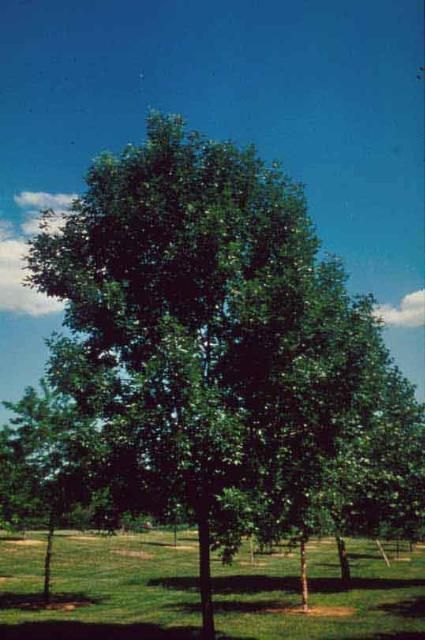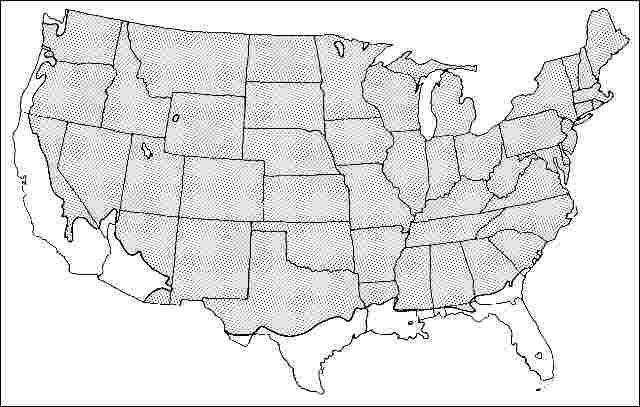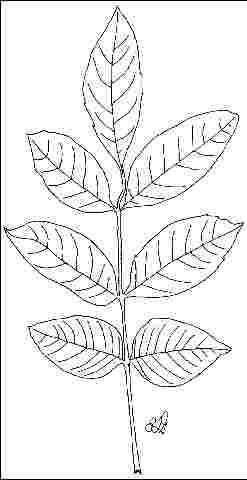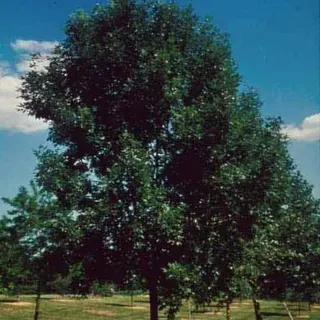Fraxinus pennsylvanica 'Marshall's Seedless': 'Marshall's Seedless' Green Ash
Introduction
This somewhat irregularly shaped tree when young, becomes an oval with age. Green ash will reach a height of about 50 feet with a spread of 40 feet. Upright main branches bear twigs which droop toward the ground then bend upward at their tips much like basswood. This usually does not interfere with traffic flow beneath the tree since branches do not droop to the ground. The glossy dark green foliage will turn yellow in the fall, but color is often muted in the south. This cultivar was supposed to be seedless but there are female trees in the population which set seed. The seeds can be produced in abundance and are considered messy. This fast-growing tree will adapt to many different landscape conditions and can be grown on wet or dry sites, preferring moist. Trees in USDA hardiness zones 8 and 9 may grow 6 to 10 feet in one year when they are young and irrigated. Some cities have overplanted green ash, and ‘Marshall Seedless' is not recommended any more due to weak branch crotches, insect problems and fruit set.

Credit: Ed Gilman, UF/IFAS
General Information
Scientific name: Fraxinus pennsylvanica
Pronunciation: FRACK-sih-nus pen-sill-VAN-ih-kuh
Common name(s): 'Marshall's Seedless' Green Ash
Family: Oleaceae
USDA hardiness zones: 3A through 8A (Figure 2)
Origin: native to North America
Invasive potential: native cultivar
Uses: reclamation; urban tolerant; shade; street without sidewalk; parking lot island > 200 sq ft; sidewalk cutout (tree pit); tree lawn > 6 ft wide; highway median

Credit: UF/IFAS
Description
Height: 50 to 60 feet
Spread: 40 to 50 feet
Crown uniformity: symmetrical
Crown shape: upright/erect, oval
Crown density: moderate
Growth rate: fast
Texture: medium
Foliage
Leaf arrangement: opposite/subopposite (Figure 3)
Leaf type: odd-pinnately compound
Leaf margin: serrate, crenate, entire
Leaf shape: ovate, lanceolate
Leaf venation: pinnate
Leaf type and persistence: deciduous
Leaf blade length: 2 to 4 inches
Leaf color: green
Fall color: yellow
Fall characteristic: showy

Credit: UF/IFAS
Flower
Flower color: green
Flower characteristics: not showy
Fruit
Fruit shape: no fruit
Fruit length: no fruit
Fruit covering: no fruit
Fruit color: no fruit
Fruit characteristics: no fruit
Trunk and Branches
Trunk/bark/branches: branches don't droop; not showy; typically one trunk; thorns
Pruning requirement: needed for strong structure
Breakage: susceptible to breakage
Current year twig color: brown, gray
Current year twig thickness: thick
Wood specific gravity: 0.56
Culture
Light requirement: full sun
Soil tolerances: sand; loam; clay; acidic; alkaline; well-drained; extended flooding
Drought tolerance: high
Aerosol salt tolerance: moderate
Other
Roots: can form large surface roots
Winter interest: no
Outstanding tree: no
Ozone sensitivity: unknown
Verticillium wilt susceptibility: susceptible
Pest resistance: sensitive to pests/diseases
Use and Management
Green ash requires regular pruning when it is young to develop a nice central trunk. It tends to develop a number of dominant upright trunks or multiple leaders if it is pruned improperly or left unpruned. Some nursery operators routinely top them in the nursery to create a bushy tree. This is not a good practice, and these trees should not be planted because they will not stay together in a strong storm. Be sure the trees have one central leader (one trunk) and branches which are well spaced along the trunk. If two major branches originate opposite each other, remove one to improve tree structure and strength.
Green ash adapts quite well to city street tree planting pits and other confined soil spaces, probably due to its tolerance to flooded and wet soil. However, extensive use as a street tree would be a risk because of potential insect and disease problems, especially emerald ash borer. Like some other rapidly growing trees, surface roots can develop and become a nuisance as they lift curbs, sidewalks and make mowing difficult. Planting only in well-drained uncompacted soil may help keep surface rooting in check. Using root barriers around the edge of planting pits and along sidewalks would deflect roots down, encouraging deeper rooting and less maintenance problems. Green ash roots can tolerate the low soil oxygen conditions present at these greater soil depths. Trees transplant easily from field nurseries or from containers and adapt to urban soils including those with high pH, salt and droughty or compacted sites. Not really for heavy clay soil.
Seedling grown trees often produce an abundance of seed which can be a nuisance, and female trees often have undesirable flower galls. Superior crown form and branching habit of other cultivars makes planting them very desirable. A few other cultivars are available and have been tested for eight-years in USDA hardiness zone 8a and appear vigorous with yellow fall color: ‘Marshall Seedless'—some seeds, yellow fall color, fewer insect problems, but losing popularity due to trees breaking apart and the population has apparently become contaminated with females since some are setting seed—'Newport' may be superior; ‘Patmore'—excellent street tree, straight trunk, good yellow fall color, seedless, USDA hardiness zone 3 to 7; ‘Summit'—female, yellow fall color, straight trunk but pruning required to develop strong structure, abundant seeds and flower galls can be a nuisance. Cultivars are budded onto seedling rootstocks.
Pests
Borers are common on ash and they can kill trees. The most common borers infesting ash are emerald ash borer (EAB), lilac borer and carpenterworm. Ash borer bores into the trunk at or near the soil line causing tree dieback, and EAB is an extensive issue in most of North America. Lilac borer causes swellings on the trunk and limbs where the insect enters the tree. The carpenterworm larvae bore into the heartwood but come to the outside of the tree to push out frass and sawdust. Heavily infested trees can be severely weakened. Keep trees as healthy as possible by fertilizing regularly and watering during dry weather.
Aphids are often seen but are usually not serious.
In late summer, fall webworm covers branches with webbing. The nests in branches close to the ground can be pruned out when first noticed.
The ash flower-gall looks like a disease but is actually a mite problem. The mites feed on the flowers causing abnormal growth. The galls dry out and persist on the tree into winter.
Diseases
A rust disease causes distorted leaves and swollen twigs. Small, yellow, cup-like structures, producing yellow spores, appear on the infected areas. Controls are usually not needed.
A number of fungi cause leaf spots on ash. The disease is worse in wet years and is partially controlled by gathering and disposing of diseased, fallen leaves.
Anthracnose is also called leaf scorch and leaf spot. Infected parts of the leaves turn brown, especially along the margins. Infected leaves fall prematurely. Rake up and destroy infected leaves. Chemical controls are not practical or economical on large trees. Trees in the south can be severely affected.
Canker diseases cause branch dieback and death of the tree when the trunk is infected. Try to keep trees healthy with regular fertilization.
Powdery mildew makes a white coating on the leaves.
Ash ring spot virus causes chlorotic green and reddish spots or rings on the leaves. Infected trees may be stunted and dieback.
Verticillium wilt causes branches of infected trees to wilt and die, eventually the entire tree may die. Keep trees healthy and fertilize infected trees with high nitrogen fertilizer to suppress disease symptoms.



